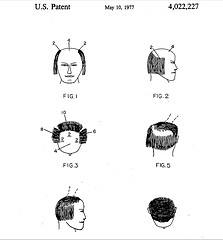Baldness Information List
If you have noticed some hair loss lately you might be worried that you are going bald. This article will give you the basic baldness information you need to know, including: the medical term for baldness; what baldness is; the causes of baldness; and treatment options for baldness
THE TECHNICAL TERMS
The technical, or medical term for baldness is alopecia areata. The word “alopecia” comes from the Greek. It means “hair loss.” The term “areata” has a Latin origin and means “occurring in patches.”
This term, alopecia, or alopecia areata, is commonly used in diagnosis of balding in a patient. If you have an appointment to visit a dermatologist for an official diagnosis, chances are this is the term you will hear.
WHAT IS BALDNESS?
Baldness is the loss of hair. This can happen in many different ways. Some hair loss is very unnoticeable. Some hair loss occurs in patches on the scalp. Still other hair loss can occur in what is known as a receding hair line.
Regardless in whatever way baldness occurs with you, it is simply the loss of hair on your head. Many men experience a receding hair line that ends up causing total hair loss on the top of the head, leaving the left and right side of the scalp with hair. Some women experience patchy hair loss or excessive thinning of the hair on top of the scalp.
CAUSES OF BALDNESS
Baldness can happen for several reasons. The most common cause of baldness is said to be hereditary genes. Lots of patients are diagnosed with hereditary baldness. If your family has a history of baldness occurring, then your chances of going bald are pretty high.
Still other causes of baldness include things like chemotherapy treatment in cancer patients and nervous habits, like excessive hair-pulling due to stress.
BALDNESS TREATMENT
Depending on the type of baldness you have, you may have several treatments options available. Today there are lots of over the counter baldness medications, like shampoos, ointments and scalp creams. Your dermatologist may also offer you a prescribed medication, depending on your situation.
Looking for Signs of Baldness
Balding is a life-changing thing that happens every single day around the world to a lot of people. For both men and women, this physical change can mean changing an entire lifestyle. It can also create a significant shift in a person’s self-image.
There are many ways to tell if a person is going bald. For a lot of people, balding begins at a very early age. Some men notice significant hair loss as early as at the age of 20. These usually end up totally bald, or ¾ bald by the time they reach their early 30’s, if not sooner.
One of the earliest signs of baldness is extreme hair loss. You may first notice a large amount of hair in your hair brush or on the floor after you brush your hair. Some people may not even pay attention to this sign of hair loss. But it is a simple sign that anyone can look for.
Another sign of baldness is thinning of the hair. For many women this begins in the front of the scalp, just about the forehead. It usually occurs in a small patch at first, then can increase in size over time. For men, thinning often begins at the crown of the head, and is therefore not noticed unless someone else points it out to him.
Another sign of baldness is a receding hairline, which is most common in men. At first, hair begins to thin and then fall out totally around the front and sides of the head. Eventually, more hair loss occurs, giving the man an appearance of his hair “sliding” down the back of his head. Thus, the name “receding hairline.”
There are many signs of baldness that can be easily spotted. The main thing to remember is that you have to be looking for these signs of baldness to find them.
Human Baldness Genetics – Who’s to Blame, Your Mother or Your Father?
The age old question regarding baldness has always been where does it come from? How does it happen? Is it hereditary? If my daddy was bald, does that mean I will be bald too? Throughout the years there has been quite a bit of studies on balding in general. Many scientists have also studied the chromosomes and genetic makeup of both balding men and their counterparts.
While there is no real conclusion so far, it is safe enough to say that male pattern baldness is hereditary. From studies conducted to date, it has been commonly found that male pattern baldness genes come from the mother’s side.
Interestingly enough, women whose father’s are bald tend to carry the bald gene. Thus, it is no surprise that when a woman whose father is bald has a son, that son usually ends up being bald, too. Now this isn’t necessarily so in every single case, but in many cases, this holds true.
Scientists explain this phenomenon by pointing to the mother’s X-chromosome. When a woman is pregnant, the child gets its x-chromosomes from the mother and the Y-chromosomes from the father. The x-chromosome is said to be the one that carries the male pattern baldness gene.
Whether the male pattern baldness genetics theory holds up or not is in question by some who do not believe the theory that males get this gene from their mother. However, time has proven to some that this theory is true for their unique cases.
Is there such a thing as male pattern baldness genetics? Is it true that if your mother’s father was bald, then you have a greater chance of being bald, too? Perhaps only time can tell. The answer to these questions is truly up to you—what do you believe?




